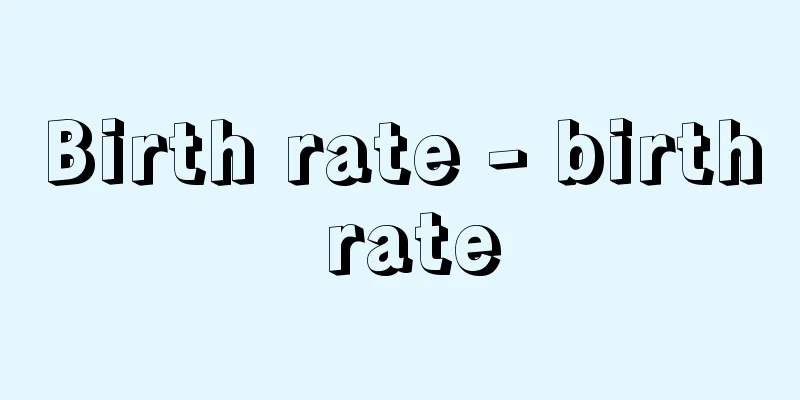Birth rate - birth rate

|
This is the ratio of the number of births per 1,000 people per year, and is also called the crude birth rate. It is expressed in per mille (‰). Fertility is the ability of a population group to give birth to children, and the birth rate is an index to measure fertility. Japan's crude birth rate in 2015 (Heisei 27) was 8.0‰. Age-specific fertility rates are calculated by classifying the number of births per year by the age of the mother and calculating the ratio of the number of births per 1,000 female population of that age. Marital fertility rates are calculated by limiting the female population used as the denominator to the married population. The total fertility rate (total fertility rate) is the sum of the age-specific fertility rates from 15 to 49 years old. The total fertility rate is an index of how many children a woman will have in her lifetime, and is often cited in relation to the issue of declining birth rates. The total fertility rate in 2015 was 1.45, which means that if 1,000 female populations gave birth to children at the age-specific fertility rate from 15 to 49 years old in 2015, they would give birth to a total of 1,450 children. 2.07 is considered to be the boundary between natural increase and natural decrease. The total fertility rate is usually expressed as the number of children per female population. The 1.45 children is the total number of boys and girls, and the total birth rate of girls by age is called the total reproduction rate. The total reproduction rate in 2015 is 0.71. If only 0.71 girls are born per female population, the population will decrease when the parent generation moves from the child generation. Furthermore, the net reproduction rate, which subtracts the number of children who die after being born, is 0.70 (2015). Japan's total fertility rate was 5.11 in 1925 (Taisho 14), and gradually declined thereafter, but rose to 4.54 in 1947 (Showa 22) during the first baby boom period after World War II. It then gradually decreased, dropping temporarily to 1.58 in 1966, the year of the Fire Horse, but then rising to 2.16 during the second baby boom period from 1971 to 1974. However, it continued to decline thereafter, dropping below 2.00 to 1.91 in 1975, and continuing to fall until the 1989 figure was 1.57, even lower than the 1.58 figure of the Fire Horse in 1966. This was noted as the "1.57 shock," and interest in the declining birthrate increased. In 1999, it was 1.34, and although it rebounded to 1.36 in 2000, it fell again to 1.33 in 2001. [Yoichi Okazaki April 18, 2017] Subsequent developmentsIt then fell to 1.26 in 2005, then recovered slightly to 1.32 in 2006, and has since shown a gradual upward trend for some time, reaching 1.45 in 2015. Similarly, the birth rate bottomed out in 2005 and showed an upward trend from 2006 to 2013, but is predicted to decline thereafter. According to the Ministry of Health, Labor and Welfare's vital statistics, the number of births in 2015 was estimated at 1,005,656, and in 2016 at 981,000. This is the first time that the number has fallen below 1 million since statistics began in 1947 (Showa 22). The background to this annual trend is that the upward trend since 2006 was due to the fact that the "baby boomer junior" generation, born between 1971 and 1974 during the second baby boom, was reaching the age of childbirth, but in 2014 the number of births among this generation decreased. In addition, the average age at which women give birth to their first child is now 30.7 years old, and there is no end to the aging of childbirth. If the proportion of first births at an older age increases, it is easy to imagine that the number of births after the second child will decrease, and it is highly likely that the future birth rate will further decline. [Editorial Department, April 18, 2017] "Demography" by Yoichi Okazaki, Revised and expanded edition (1999, Kokin Shoin) [Reference items] | |Source: Shogakukan Encyclopedia Nipponica About Encyclopedia Nipponica Information | Legend |
|
人口1000人に対する1年間の出生数の比率のことで、普通出生率ともいう。パーミル(‰)で表示する。一つの人口集団が子供を産む力を出生力といい、出生率は出生力を測定する指標である。2015年(平成27)の日本の普通出生率は8.0‰である。 1年間の出生数を母親の年齢別に分類し、年齢別女子人口1000人に対する出生数の比率を計算したものが年齢別出生率である。分母にとる女子人口を有配偶人口に限定して年齢別出生率を計算したものが有配偶出生率である。また15~49歳までの年齢別出生率を合計したものが合計特殊出生率(合計出生率)である。合計特殊出生率は、1人の女性が一生の間に何人の子供を産むかの指数であり、少子化問題に関連して引用されることが多い。2015年の合計特殊出生率は1.45であるが、それは1000人の女子人口が、15~49歳までの2015年の年齢別出生率で子供を産んだと仮定すれば、合計で1450人の子供を産むことを示している。2.07が自然増と自然減の境目とされている。そして合計特殊出生率は、通常、女子人口1人当りの子供数で示される。1.45人の子供は男児と女児の合計であって、女児だけの年齢別女児出生率の合計を総再生産率という。2015年の総再生産率は0.71になる。女子人口1人について0.71人しか女児を産まないとすれば、親の世代から子の世代に移るときの人口が減少することになる。さらに、産まれてから死亡する子供数を差し引いた純再生産率は0.70(2015)である。 日本の合計特殊出生率は、1925年(大正14)には5.11で、その後しだいに低下しつつあったが、第二次世界大戦後の第一次ベビーブーム期の1947年(昭和22)には4.54に上昇した。その後は漸減し、1966年の丙午(ひのえうま)の年に一時的に1.58に下がったものの、1971~1974年の第二次ベビーブーム期には2.16まで上昇した。しかし以降は低下が続き、1975年に1.91と、2.00を下回ってから下がり続け、1989年の数値では1966年丙午の1.58をさらに下回る1.57となり「1.57ショック」として注目され、少子化への関心が高まった。1999年には1.34となり、2000年に1.36と盛り返したものの2001年にはふたたび1.33に低下した。 [岡崎陽一 2017年4月18日] その後の動きその後は2005年に1.26まで落ち込んだあと、2006年には1.32とわずかながら回復し、その後しばらくの間ゆるやかな上昇傾向を示しており、2015年には1.45となっている。 出生率も同様に、2005年を底として2006~2013年までは上昇傾向を示していたが、その後は減少が予測されている。厚生労働省の人口動態統計によると、2015年の出生数は100万5656人、また2016年の出生数は98万1000人と推計されている。100万人割れは1947年(昭和22)の統計開始以来初めてのことである。こうした年次推移の背景として、2006年からの上昇傾向は、第二次ベビーブーム期の1971~1974年生まれの「団塊ジュニア」世代が出産の時期を迎えていたが、2014年にはこの世代の出産が減ったことが影響している。また、女性が第1子を産む平均年齢は30.7歳となり、出産の高齢化に歯止めがかからない。高齢初産の比率が高まれば、第2子以降の出産が減ることが容易に想像され、将来的な出生率はさらに低下する可能性が高い。 [編集部 2017年4月18日] 『岡崎陽一著『人口統計学』増補改訂版(1999・古今書院)』 [参照項目] | |出典 小学館 日本大百科全書(ニッポニカ)日本大百科全書(ニッポニカ)について 情報 | 凡例 |
<<: Shusse-uo - Fish that grows bigger
>>: Prenatal Pediatrics - Prenatal Pediatrics
Recommend
Indias
A general term for the areas discovered, conquered...
Inabe
Also written as Tamenabe. They were one of the pro...
Curassow (Crested Bird) - Curassow
A general term for 44 species of birds in the Crac...
Reichenberg
...Population: 101,000 (1996). In German, it is c...
Wu Ling Wang (English: Wǔ líng wáng)
King of Zhao during the Warring States period in C...
screw dislocation
…Therefore, the dislocation line is not broken in...
Foreign Guard
〘Noun〙 The military of the Ritsuryo state establis...
Kanetataki (gong-hitting) - Ornebius kanetataki (English spelling)
An insect of the Orthoptera order, family Ploceida...
Air sac - Yesterday (English)
An organ unique to birds, a thin membrane sac atta...
Carpaccio - Vittore Carpaccio
A Venetian painter of the Italian Renaissance. Bo...
Baiera
...This plant had a pair of thin linear leaves, b...
Italian Symphony
…In the same year, he traveled to England, and th...
Mr. Iio - Good King
In the past, it was read as "Iino" or &...
Turanshah (English spelling)
In 1169, Salah al-Din became the vizier of the Fa...
Autumn Washing
...There were various kinds of songs according to...









